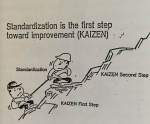Why is “don’t restructure, help ground teams to make it work” so subversive?
At it’s simplest, lean leadership is about helping ground teams to make things work before restructuring.
It goes this way:
- The leader goes to the gemba and looks into improvement projects the teams have taken upon themselves to do: what problems they fix to help their mission with customers, and how they go about it?
- From these gemba visits, the leader frames higher-level challenges for each department in the organization: if we want to satisfy our customers better and provide them with an advantage our competitors don’t, what is the technical problem we need to learn to solve better?
- Frontline teams can then align their improvement efforts on taking on these challenges, and repeated efforts at solving this problems in concrete, diverse situations, will eventually make new ways of working emerge.
- As the leaders keep visiting the gemba and looking deeply into what the teams do, they will eventually come up with reorganization or investment ideas, which will be formed and discussed with the teams themselves, making the implementation seamless.

How hard can it be?
On top of which, lean give us a method to do it:
- Focus on Safety, Quality, Delivery, Lead-time, Cost, Morale and Energy Performance improvement targets to figure out first Value Analysis projects and then Value Engineering projects.
- Learn to spot defects early and stop work at each defect to investigate what went wrong in the conditions in which it went wrong and deepen the technical understanding of everything we do.
- Flow work at the customer’s sales rhythm one piece at a time to be able to focus on the quality of each piece of work and determine the capacity really needed to achieve 100ù of the schedule (something you can never do as long as you batch) to avoid points of overburden.
- Engage teams in feeling better about their work by studying deeply their standards and improving their own ways of working so they feel more confident about owning their jobs and responsible about their own work and working with colleagues across functions.
- Develop trust between teams and management, through stabilizing teams and equipment and involving all in daily maintenance routines such as stand-up meeting, 5S, TPM, and following up on suggestions.
We know what we want to do. We have a method to do it. Leaders who try it for real succeed! We’ve got twenty-five years of documented cases to back up this claim. So where is the problem?
Truth is – I don’t know. So many serious leaders seem to be completely freaked out by what is required of them. They feel that lean 1) asks a lot of them by going to the gemba and listening (rather than telling) and 2) that it takes away their job of having a vision and coming up with the high-level strategies to realize it, and making others execute, no matter what.
We probably don’t help by demonstrating every time how immensely wasteful strategy blunders and restructuration efforts are for everyone involved: the overcoats involved for the business add up in millions of $!
Ground teams usually love lean. Execs and unions dismiss or bad mouth it. I face this problem every day, and it definitely feels beyond my pay grade: I simply don’t know how to face this particular challenge.
Ideas, any one?









